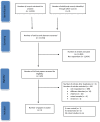Botulinum Toxin-A High-Dosage Effect on Functional Outcome and Spasticity-Related Pain in Subjects with Stroke
- PMID: 37624266
- PMCID: PMC10467116
- DOI: 10.3390/toxins15080509
Botulinum Toxin-A High-Dosage Effect on Functional Outcome and Spasticity-Related Pain in Subjects with Stroke
Abstract
Stroke patients can develop spasticity and spasticity-related pain (SRP). These disorders are frequent and can contribute to functional limitations and disabling conditions. Many reports have suggested that higher doses than initially recommended of BTX-A can be used effectively and safely, especially in the case of severe spasticity; however, whether the treatment produces any benefit on the functional outcome and SRP is unclear. Studies published between January 1989 and December 2022 were retrieved from MEDLINE/PubMed, Embase, and Cochrane Central Register. Only obabotulinumtoxinA (obaBTX-A), onabotulinumtoxinA, (onaBTX-A), and incobotulinumtoxinA (incoBTX-A) were considered. The term "high dosage" indicates ≥600 U. Nine studies met the inclusion criteria. Globally, 460 subjects were treated with BTX-A high dose, and 301 suffered from stroke. Studies had variable method designs, sample sizes, and aims. Only five (55.5%) reported data about the functional outcome after BTX-A injection. Functional measures were also variable, and the improvement was observed predominantly in the disability assessment scale (DAS). SRP pain was quantified by visual analog scale (VAS) and only three studies reported the BTX-A effect. There is no scientific evidence that this therapeutic strategy unequivocally improves the functionality of the limbs. Although no clear-cut evidence emerges, certain patients with spasticity might obtain goal-oriented improvement from high-dose BTX-A. Likewise, data are insufficient to recommend high BTX dosage in SRP.
Keywords: botulinum toxin A; functional outcome; high dose; pain; spasticity; stroke.
Conflict of interest statement
The authors declare no conflict of interest.
Figures
References
-
- Lance J.W., Feldman R.G., Young R.R., Koeller C. Spasticity: Disordered Motor Control. Yearbook Medical; Chicago, IL, USA: 1980. pp. 485–494.
-
- Pirazzini M., Azarnia Tehran D., Zanetti G., Megighian A., Scorzeto M., Fillo S., Shone C.C., Binz T., Rossetto O., Lista F., et al. Thioredoxin and its reductase are present on synaptic vesicles, and their inhibition prevents the paralysis induced by botulinum neurotoxins. Cell Rep. 2014;8:1870–1878. doi: 10.1016/j.celrep.2014.08.017. - DOI - PubMed
Publication types
MeSH terms
Substances
LinkOut - more resources
Full Text Sources
Medical
Miscellaneous


